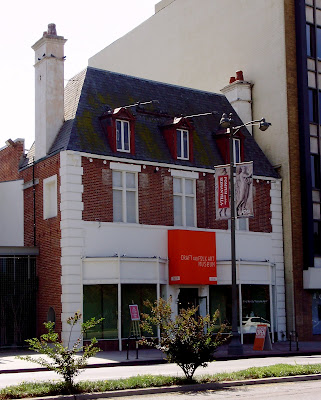I chose the Craft and Folk Art Museum, located on (in?) the Miracle Mile. I've been thinking a lot about the intersections of theory and practice, which always ties into ideas of beauty and functionality for me; craft museums are an excellent place to examine this. I was very interested in seeing the Myth and Manpower: Graphics and the California Dream exhibit. There was also an exhibit of the work of Dora De Larios, Suenos/ Yume: 50 Years of the Art of Dora De Larios.
The museum itself is tiny, and slightly (delightfully) incongruous, brick and plaster amongst the buildings of steel and glass up and down Wilshire. There are three floors, the top two for the exhibits, and a classroom, welcome desk, and gift shop on the ground floor. The plaster inside is unevenly patched, and the wood floors are worn down in certain places-- much less sterile than most museums-- I felt like this was perfect for the art, which really, is the art of the people.

Dora De Larios focuses on ceramics and sculpture; the fascination of this exhibit is the range of her pieces, starting in the 1950's, which reminded me of those heavy earthenware bowls to get excited over in thrift stores, to her contemporary work, which focuses on aspects of the goddess and these marvelous ceramic animals. My favorite piece by her was a metal and wood sculpture from the 1960's or early 1970's, entitled "Warrior." The figure has his head thrown far back, guarding his body with a shield, and is standing on one leg with a large foot; the other leg is cut off just above the knee. The awareness of the strength in body in the piece made me very aware of my own body-- just what it is to stand.
The Myth and Manpower exhibit was very powerful; the whole floor is chunked off in bold citrus colors, with floor-to-ceiling text discussing the forms of graphic art. Sectioned along the wall are pairings of fruit crate labels, sent East to entice migration to California, and UFW-centric protest posters. Comparing the fairy-tale world of boosterism to the graphic starkness of the silk-screened posters was the perfect bundling of California, the glamour and the glitter thick over this history of oppression and the activism that rose (rises) from it. The comparison of a fruit crate label close-up of a rosy-cheeked blonde, smiling through perfect teeth (from eating Sunkist fruit, I guess) next to a stark, simple print in the same pinks and blues of Dolores Huerta was a beautiful place to consider that intersection of beauty and functionality, and where each rises from-- which is the commodity, and which is of worth?
Then, to bring it down a notch, I walked across the street to the La Brea Tar Pits. Blech. They have this horrible sculpture of a female mammoth being sucked into the tar pit, while her mate and baby watch, their trunks stretched out to her. This really upset me; I felt really bad for this mammoth. I know if I was a kid visiting the tar pits, I would just be heart-broken by this scene. It's worse than Bambi, because you can see the mom sinking away right in front of your eyes, and it's perpetual-- this whole mammoth family is being frantically pulled apart until someone more sensitive is in charge of the pits. I didn't even take a picture of them-- it made me too sad. But here's the pits anyway.

And not only are they heart-wrenching, they stink to high heaven.





No comments:
Post a Comment